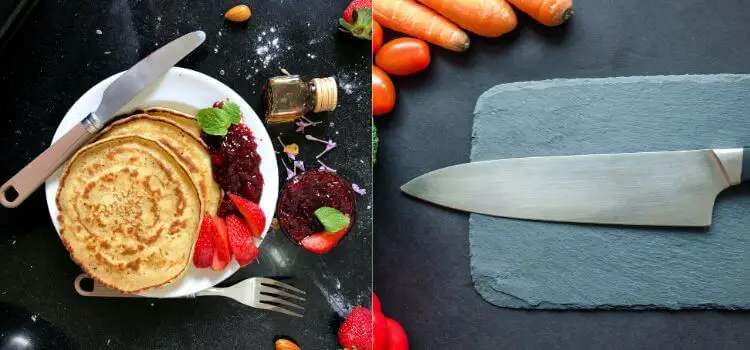As an Amazon Associate, I earn from qualifying purchase.
Introduction:
When it comes to slicing and dicing in the kitchen, having the right tool for the job can make all the difference. Whether cutting through a tough crust on a loaf of bread or slicing through a juicy steak, the type of knife you use can greatly affect the outcome. Serrated Knife vs Straight Edge which one should you select?
Two popular knives are the serrated knife and the straight-edge blade. Each has unique benefits and drawbacks, so which should you choose? This article will examine the serrated knife vs. straight-edge debate and help you make an informed decision.

What is a serrated knife?
A serrated knife is a kitchen knife with a jagged edge with multiple teeth or serrations. The serrations allow the knife to cut through tough, crusty bread without squishing it. Serrated knives are also great for slicing through delicate fruits like tomatoes and citrus, as the serrations prevent the fruit from getting crushed.
Types of serrated knives
Not all serrated knives are created equal. There are two main types of serrated knives: the bread knife and the tomato knife.
The bread knife is a long, slender knife with a serrated edge. It’s designed to cut through crusty bread without squishing it. The length of the blade allows you to cut through large loaves of bread with ease.
The tomato knife, on the other hand, is a shorter serrated knife with a pointed tip. It’s designed to slice through delicate fruits and vegetables like tomatoes, citrus, and kiwi. The pointed tip lets you pierce the fruit’s skin without squishing it.
Buy Serrated Knife: Mercer Culinary M23210 Millennia Black Handle

Pros
Cons
What is a straight-edge knife?
A straight-edge knife, a chef’s knife, is a versatile kitchen tool with a smooth, sharp blade. It’s ideal for slicing, chopping, and dicing various foods, including meat, vegetables, and fruits.
Types of straight-edge knives
There are several types of straight-edge knives, including the chef’s knife, the utility knife, and the paring knife.
The chef’s knife is a large, versatile knife perfect for chopping, slicing, and dicing various foods. The blade is usually between 8 and 10 inches long.
The utility knife is a smaller version of the chef’s knife, with a blade usually between 4 and 7 inches long. It’s great for cutting sandwiches, slicing cheese, and trimming meat.
The paring knife is a small, lightweight knife with a blade usually between 2 and 4 inches long. It’s great for peeling and trimming fruits and vegetables.
Buy straight-edge knife: Calphalon Kitchen Knife Set with Self-Sharpening Block

Pros
Cons
Serrated Knife vs. Straight Edge: Which One is Right for You?
Now that you know the pros and cons of each type of knife, which one should you choose? The answer depends on what you’ll be using the knife for.
For Bread and tomatoes: Serrated Knife vs Straight Edge?
A serrated knife is a way to go if you frequently cut through crusty bread or delicate tomatoes. The serrations allow the knife to cut through these foods without squishing them.
For Meat and vegetables: Serrated Knife vs Straight Edge?
A straight-edge knife is better if you frequently slice through meats and vegetables. The smooth blade allows precise cuts and can easily slice through these foods.
Versatility
A straight-edge knife is a way to go if you’re looking for a versatile kitchen knife that can handle various tasks. While serrated knives are great for specific tasks, straight-edge knives can be used for various slicing and chopping tasks.
Cuisinart C77TR-S6SK Triple Rivet Collection Straight Edge

Serrated Knife vs. Straight Edge: FAQs
A serrated knife is better for cutting bread as it can cut through the tough crust without crushing the soft interior.
Yes, you can sharpen a serrated knife using a special serrated knife sharpener or a round sharpening stone.
Serrated knives are often more durable than straight-edge blades because their teeth aren’t damaged as easily as a straight-edge blade’s edge.
While serrated knives are not ideal for precision cutting, they can be used for tasks that require a sawing motion, such as slicing through tough-skinned fruits or vegetables.
Conclusion
Choosing between a serrated knife and a straight-edge blade depends on personal preference and the tasks you’ll use the knife for. Both types of knives have unique benefits and drawbacks, so it’s important to consider your needs and preferences before deciding.
A serrated knife is a way to go if you frequently cut through tough materials like bread or meats with tough skin or scales. However, a straight-edge blade is the better choice if you need a knife for precision cutting or slicing through delicate materials.
Ultimately, the key to getting the most out of your knife is to choose a high-quality blade and maintain it properly. Regular sharpening and proper cleaning will help ensure your knife stays sharp and effective for years.
So whether you choose a serrated knife or a straight-edge blade, treat it with care and respect – after all, it’s one of the most important tools in your kitchen!
Leave a Reply